

| Note please: the images of the capitals and piers of the cloister are arranged in clockwise order from the northwest corner. The order of the galleries is thus: north, east, south, and west. | ||
Marble intermediate pier with Abbot Durandus, abbot of Moissac from 1047-1071, and later Bishop of ToulouseThe pier reliefs represent images of some of the Apostles as well as the former abbot of Moissac. He is represented as the Apostles are (even to the halo) with the exception that he faces the viewer frontally. The suggestion seems to be that he is a successor of the Apostles in his monastic vocation. The placement of this Durandus relief, opposite the Chapter House where monastic meetings were held, also "conferred the aura of apostolic dignity upon all the monks" (Hearn 126). | ||
| While some Apostles are barefoot or in sandals, the abbot, like Philip, wears shoes--here with a strange scalloped design. And while proportions vary among them, Durandus is short and squatty. Like them, he is flat without much suggestion of a three-dimensional body--a style often compared to ivory carving. | 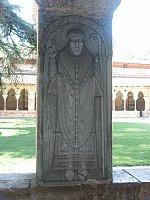
|
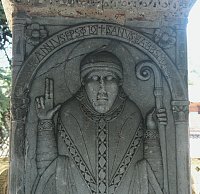
|
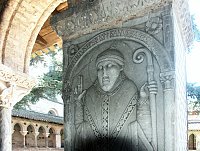
|
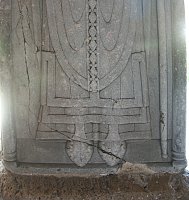
|
He is arranged symmetrically with his vestments echoing both the arch at the top and the rectangle of the pier. The folds are decorative and rhythmical and the edges of the drapery are emphasized by parallel engraved lines. The chausable is divided vertically with a decorative line of lozenges, presumably representing a jewelled band--also seen in James' clothing. He holds a crozier, the symbol of his pastoral leadership. |
The intermediate range of columns and the pier on which the marble slabs representing Durandus are attached |

|

|
Left: griffon capital; center: foliate capital with palm fronds; foliate capital with alphabet on the upper rim of the abacus | ||
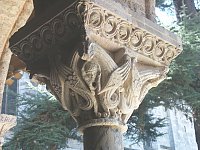
|

|

|

|
Martyrdom of St PeterThe north face of the capital depicts Peter's crucifixion upside down as Peter had requested, since he did not want to imitate his master Christ. (Early church fathers wrote that he was crucified upside down in Rome and this tradition was illustrated by medieval artists as well as later painters like Michelangelo and Caravaggio.) The executioners flank the cross, each holding some kind of implement. The towers of a city are at both corners--Rome? | |
North face of the capital: Samson and the LionSamson wrestles with a fierce lion, with oversized paws and claws and a flashy tail. An inscription at the top identifies him. He seems to have full rich hair! The wing of the angel standing to the left is also visible. |
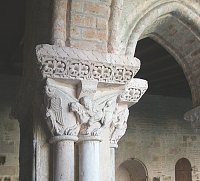
|
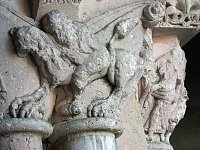
|

|
Looking southeast |
|
Works Consulted or Quoted:
M. F. Hearn. Romanesque Sculpture: The Revival of Monumental Stone Sculpture in the Eleventh and Twelfth Centuries. Ithaca, NY: Cornell UP, 1981.
Meyer Schapiro. The Sculpture of Moissac. NY: Braziller, 1985.
M. Alison Stones. Extensive medieval website.
 Go to Moissac Index.
Go to Moissac Index.
 Click here to return to index of art historical sites.
Click here to return to index of art historical sites.
 Click here to return to index of artists and architects.
Click here to return to index of artists and architects.
 Click here to return to chronological index.
Click here to return to chronological index.
 Click here to see the home page of Bluffton University.
Click here to see the home page of Bluffton University.

